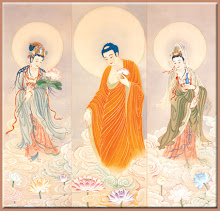
Samantabhadra or The Bodhisattva of Universal Virtue usually rides on a six-tusked white elephant. In chinese, she is known as Pu Hsien Pusa. The six tusks represents overcoming the attachment to the senses. It also signifies the Six Paramitas (perfections), i.e. charity,morality, paitence, diligence, contemplation and wisdom.
The paramitas are the six ways Bodhisattvas pursue their spiritual practice to attain full enlightenment to benefit all sentient beings. Samantabhadra embodies all the practices which must be fulfiled in order to attain Buddhahood.
According to the Flower Garland Sutra, a Bodhisattva practitioner must dedicate all of his or her efforts towards the enlightenment of all sentient beings and to dedicate everything for the welfare of all.
In this way, all selfishness and the self-cherishing manner are completely transcended, and one enters the ocean of merits of all enlightened beings.
Samantabhadra Bodhisattva is also famous for his practice of the Bodhisattva's Ten Great Vows:
1. To respect all Buddhas
2. To make praises to infinite number of Buddhas
3. To make extensive offerings to all the Buddhas
4. To confess and purify all negative karmas
5. To rejoice in the merits of others
6. To request the turning of the Dharma Wheel (Buddha's teachings)
7. To request the Buddha to remain in the world to benefit all beings
8. To always follow the Buddha's path
9. To live harmoniously with all living beings
10.To dedicate all merits for the welfare of all living beings
A chinese monk, Hui Chih, went to Er Mei Shan in China, and built a temple devoted to Samantabhadra in 399 A.D. Since than, Er Mei Shan has become the sacred site of Samantabhadra.
The paramitas are the six ways Bodhisattvas pursue their spiritual practice to attain full enlightenment to benefit all sentient beings. Samantabhadra embodies all the practices which must be fulfiled in order to attain Buddhahood.
According to the Flower Garland Sutra, a Bodhisattva practitioner must dedicate all of his or her efforts towards the enlightenment of all sentient beings and to dedicate everything for the welfare of all.
In this way, all selfishness and the self-cherishing manner are completely transcended, and one enters the ocean of merits of all enlightened beings.
Samantabhadra Bodhisattva is also famous for his practice of the Bodhisattva's Ten Great Vows:
1. To respect all Buddhas
2. To make praises to infinite number of Buddhas
3. To make extensive offerings to all the Buddhas
4. To confess and purify all negative karmas
5. To rejoice in the merits of others
6. To request the turning of the Dharma Wheel (Buddha's teachings)
7. To request the Buddha to remain in the world to benefit all beings
8. To always follow the Buddha's path
9. To live harmoniously with all living beings
10.To dedicate all merits for the welfare of all living beings
A chinese monk, Hui Chih, went to Er Mei Shan in China, and built a temple devoted to Samantabhadra in 399 A.D. Since than, Er Mei Shan has become the sacred site of Samantabhadra.

No comments:
Post a Comment